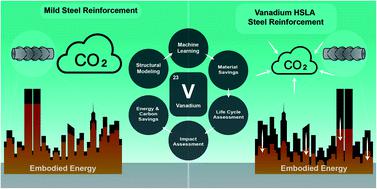当前位置:
X-MOL 学术
›
Environ. Sci.: Processes Impacts
›
论文详情
Our official English website, www.x-mol.net, welcomes your feedback! (Note: you will need to create a separate account there.)
Punching above its weight: life cycle energy accounting and environmental assessment of vanadium microalloying in reinforcement bar steel
Environmental Science: Processes & Impacts ( IF 5.5 ) Pub Date : 2020-12-10 , DOI: 10.1039/d0em00424c Pranav Pradeep Kumar 1, 2, 3, 4, 5 , David A. Santos 2, 3, 4, 6, 7 , Erick J. Braham 2, 3, 4, 6, 7 , Diane G. Sellers 2, 3, 4, 6, 7 , Sarbajit Banerjee 2, 3, 4, 6, 7 , Manish K. Dixit 2, 3, 4, 5
Environmental Science: Processes & Impacts ( IF 5.5 ) Pub Date : 2020-12-10 , DOI: 10.1039/d0em00424c Pranav Pradeep Kumar 1, 2, 3, 4, 5 , David A. Santos 2, 3, 4, 6, 7 , Erick J. Braham 2, 3, 4, 6, 7 , Diane G. Sellers 2, 3, 4, 6, 7 , Sarbajit Banerjee 2, 3, 4, 6, 7 , Manish K. Dixit 2, 3, 4, 5
Affiliation

|
Steel-reinforced concrete is ubiquitously used in construction across the world. The United Nations estimates that the worldwide energy consumption of buildings accounts for 30–40% of global energy production, underlining the importance of the judicious selection of construction materials. Much effort has focused on the use of high-strength low-alloy steels in reinforcement bars whose economy of materials use is predicated upon improved yield strengths in comparison to low-carbon steels. While microalloying is known to allow for reduced steel consumption, a sustainability analysis in terms of embodied energy and CO2 has not thus far been performed. Here we calculate the impact of supplanting lower grade reinforcement bars with higher strength vanadium microalloyed steels on embodied energy and carbon footprint. We find that the increased strength of vanadium microalloyed steel translates into substantial material savings over mild steel, thereby reducing the total global fossil carbon footprint by as much as 0.385%. A more granular analysis pegs savings for China and the European Union at 1.01 and 0.19%, respectively, of their respective emissions. Our cradle-to-gate analysis provides an accounting of the role of microalloying in reducing the carbon footprint of the steel and construction industries and highlights the underappreciated role of alloying elements.
更新日期:2020-12-23


























 京公网安备 11010802027423号
京公网安备 11010802027423号